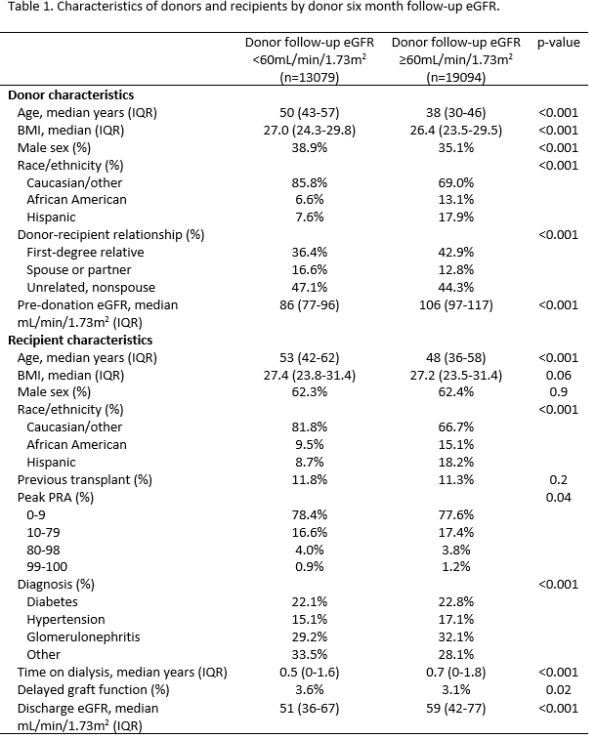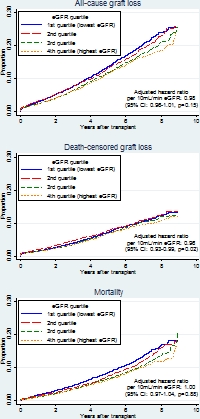Relationship between Living Kidney Donor Follow-Up GFR and Recipient Graft Loss
1Johns Hopkins School of Medicine, Baltimore
2Johns Hopkins School of Public Health, Baltimore
3Scientific Registry of Transplant Recipients, Minneapolis.
Meeting: 2018 American Transplant Congress
Abstract number: 224
Keywords: Graft failure, Kidney transplantation, Nephrectomy
Session Information
Session Name: Concurrent Session: Kidney Living Donation: Donor and Recipient Outcomes
Session Type: Concurrent Session
Date: Monday, June 4, 2018
Session Time: 2:30pm-4:00pm
 Presentation Time: 3:42pm-3:54pm
Presentation Time: 3:42pm-3:54pm
Location: Room 6E
In living kidney transplantation, it is reasonable to believe a donated kidney's function would be associated with the function of the donor's remaining kidney. Indeed, recipients of kidney transplants from living donors who themselves develop ESRD have higher mortality and graft loss. We hypothesized that there would be an association along the full range of follow-up donor kidney function with recipient outcomes.
Methods: We studied SRTR data from 2008-2016 to determine the association between early donor follow-up eGFR and recipient graft loss and mortality, using Kaplan-Meier curves and Cox proportional hazards models.
Results: We found that donors with a six month follow-up eGFR<60 were older, more likely male, more likely to be white, and had lower pre-donation eGFR than those with higher follow-up eGFR (Table 1). Their recipients were also older and more likely to be white (Table 1). There was an association between six month post-donation eGFR and recipient graft loss and mortality (Figure 1). After controlling for multiple donor and recipient factors including donor preoperative eGFR, higher post-donation follow-up eGFR was associated with lower death-censored graft loss (per 10mL/min, adjusted hazard ratio 0.96, p=0.02, Figure 1).
Conclusion: Recipients of kidneys donors who develop post-donation kidney dysfunction have higher risk of graft loss after controlling for multiple donor and recipient factors. A better understanding of donor response to nephrectomy can inform recipient management.
Figure 1. Association between living donor six month follow-up eGFR and recipient graft loss and mortality.
CITATION INFORMATION: Holscher C., Ishaque T., Haugen C., DiBrito S., Jackson K., Muzaale A., Massie A., Henderson M., Garonzik Wang J., Segev D. Relationship between Living Kidney Donor Follow-Up GFR and Recipient Graft Loss Am J Transplant. 2017;17 (suppl 3).
To cite this abstract in AMA style:
Holscher C, Ishaque T, Haugen C, DiBrito S, Jackson K, Muzaale A, Massie A, Henderson M, Wang JGaronzik, Segev D. Relationship between Living Kidney Donor Follow-Up GFR and Recipient Graft Loss [abstract]. https://atcmeetingabstracts.com/abstract/relationship-between-living-kidney-donor-follow-up-gfr-and-recipient-graft-loss/. Accessed December 16, 2025.« Back to 2018 American Transplant Congress


